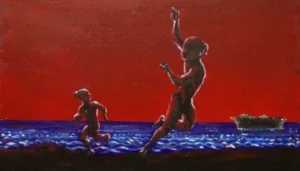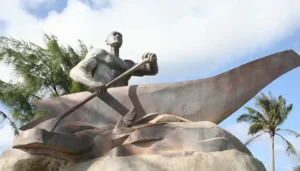






Learn more about the exceptional sailing and fishing skills of the ancient Chamorros.

Did you know that Chamorros were the only Pacific Island people who cultivated rice in ancient times? Click here to discover rice cultivation in the Marianas!

The Mariana Islands have a history of pottery-making that spans over 3,500 years.

Subscribe to Guampedia’s Pulan newsletter, and explore our past newsletters, to learn more about the ancient Chamorro calendar and dive deeper into Marianas history and cultural traditions.

Catholic Devotional Prayers. The Nobenan Niñu is held during the Christmas season with the last day ending on either Christmas Eve, Christmas Day, New Year’s Eve, New Year’s Day, or on Three King’s Day in early January.

Guam’s Rocky Road to Self-Governance. In honor of the 75th anniversary of Guam’s Organic Act, Dr. Anne Hattori explores how the Organic Act emerged from longstanding Chamorro protests, and the unfinished work of self-determination.

Algae are naturally occurring members of marine environments, with natural fluctuations in light and temperature throughout the year driving seasonal patterns of algal abundance.

HÅFA ÅDAI!
Si Yu’os Ma’åse’ for visiting Guampedia! Through local, regional, national and global partnerships, our site provides access to more than 1,500 fact-checked entries, about 4,000 images and extensive multimedia collections, resources and links.

Pathways
We now feature three direct Pathways to educational resources, the cultural and historical landscapes of the Marianas archipelago, and our wider region of Micronesia in the Western Pacific ocean. Our Pathways invite you to take a deep dive into these rich histories from an islander-centered perspective.
Guampedia’s Sections encompass the vast cultural landscapes of our islands’ more than 3,500 year human history. Not sure where to start? Each Section opens with an introduction to the subject (whether it’s Creative Expression, the Natural Environment, or entries on Marianas heritage and culture) and offers an array of relevant written entries, media, and pathways to more resources.
Our collections reflect the rich cultural landscapes of the 3,500 year human history of the Marianas and our sister islands throughout Micronesia. These collections feature islander centered resources. Each section offers a deeper dive into over 100 subject categories offering an array of written entries, relevant media and pathways to more resources.
Explore the breadth and depth of the people and the islands of the Western Pacific - MicrONEsia!
Creative Expressions
Traditional and contemporary arts and artisans.
Dive In
Learn about Our Heritage, discover inspiring e-publications, and explore our natural environments. Take a journey through indigenous lenses as we traverse the timeline, listen to voices of the past, and dive in to every resource made available to you on Guampedia.

Folktale: Dinague Laolao
Back in the ancient days, giants with supernatural strength inhabited the Mariana Islands.

Folktale: Gadao’s Strength
Once upon a time, a long time ago, on the island of Guahan in the

Fo’na
Mother of the Chamorro people. Fo’na is the female protagonist of the Chamorro/CHamoru creation myth.

Johnny Sablan
Johnny Sablan, (1948 – ) a pioneer Chamorro recording artist, received the “Island

Maria Yatar McDonald
Maria Yatar McDonald (1955 – ) is a multi-talented musician, traditional tattoo and
Stay & Watch
Stay Connected
Sign-up to receive quarterly updates on new articles, posts, events, and more from Guampedia!






